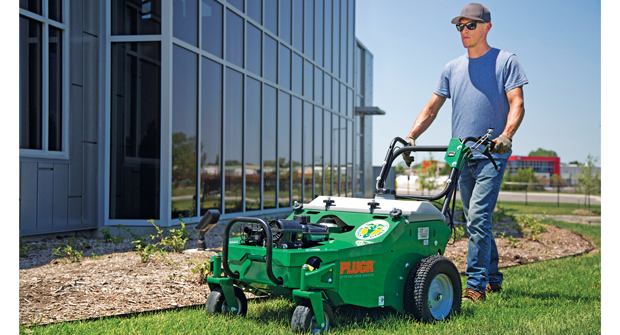
Before aerating a lawn, employees must understand what aerators do, why this service is important and how to achieve the best results.
Aeration should be a part of lawn care operators’ (LCOs) services to promote turf health, says Jeb Fregm, sales and marketing manager of Earth & Turf Products. Aerators poke holes in turfgrass to allow air, water and other nutrients to reach the roots, where soil is compacted. This practice is especially important for lawns and turf areas with high traffic because the soil will become hard on the surface, which doesn’t allow water to be absorbed.
Getting started
Before aerating, employees should pick up any debris or items on the lawn and ensure the soil isn’t dry. Fregm suggests attaching a drag mat to the aerator to smooth out cores that are left behind and bring the surface back to normal. Operators should avoid using an aerator on driveways or surfaces that could be damaged or hurt the equipment.

For turf areas with compacted or clay soil, making a second pass with the aerator can make a big difference. “It takes a little more time, but it can really advance the soil if it needs to be loosened up,” Fregm says.
While aeration is important, it works best when LCOs include it as part of the bigger picture of turf health.
“Poke holes to let the turf breathe and then topdress and overseed alongside it to get fresh turf to come out. That will give you something nutritional to fill in the holes after you aerate,” Fregm says. “If you can add in the other parts of the recipe, the results will be better, and the customer will be happier.”
Achieve dense aeration
In most cases, LCOs aerate turf annually, says Brandon King, product manager for Billy Goat. Warm-season turf should be aerated between mid-April and June, whereas cool-season turf should be aerated between the end of August to mid-October.
“If you loosen up the soil, it frees up the roots to grow easier and deeper,” King says. “The deeper the root grows, the more drought resistant the plant becomes.”

Mowing the turf shorter before aerating helps the tines better penetrate the soil. King recommends cutting it about 1/4-inch shorter a few days before aeration is planned. If it hasn’t rained recently, operators should water beforehand to ensure they achieve deep cores. Things like shallow TV cable lines, dog fences, sprinkler heads and valve boxes should also be marked ahead of time so they aren’t damaged, King adds.
The soil’s compaction, goals for the turf and the type of aerator being used will help determine if more than one pass is needed. For example, drum aerators can disturb about 2 percent of the soil in a single pass, and reciprocating aerators can do about 8 to 10 percent in a pass, King says.
“If you’re looking to do a good job, dense aeration is a must,” King says. “Try to get a density in the 8- to 10-percent range to notice the effects of the aeration.”
Operators should also map out their paths near fences and houses so they are able to turn the machine without hitting the structures or getting stuck in an area, King says. They should also limit their foot traffic across driveways or sidewalks.
“Walk in the same spots so you can minimize what you have to clean up,” King says.
Crews often underestimate how fatiguing aeration can be on the equipment operators, so it’s important to have enough employees to handle all of the aeration projects without wearing out your team.


